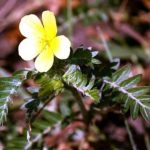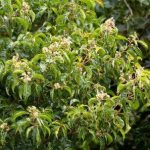TREE LIFE
JANUARY 1994
MASHONALAND CALENDAR
Saturday 1st January. HAPPY NEW YEAR Meet at the Mukuvisi Woodlands car park at 3.00 p.m. for Mark’s Botanic Interest Walk. The area he proposes to explore has, in the past, revealed some very interesting species.
Tuesday 4th January. Botanic Garden Walk. Park at the Herbarium where we will meet Tom Muller at 4.45 for 5 p.m.
Sunday 16th January. On our recce we were pleasantly surprised by the amount of unspoiled Brachystegia woodland to be found on Kent Estate, and we have chosen a very pleasant mini-kopjie for our January outing. All indications are that this rainy season is going to be wonderfully wet so come prepared for a possible drenching. Total distance from Harare is about 55 km and 1¼ hours driving time, to meet at 10.00 a.m.
Saturday 22nd January. At 3.00 p.m. a Botanical Interest Walk with Mark on the vlei at the end of Chinyika Road in Marlborough.
Tuesday 1st February. Botanic Garden Walk
THE MATABELELAND CALENDAR
Saturday 1st January. New Year’s Day lunchtime social at the home of Tom and Mary Raube, 19 George Road in Khumalo (Phone 68284). Time 11.30 for 12.00 noon. This is a ‘bring and share’ and either Margaret or Mary will have contacted you by now with regard to your contribution. If this has not happened, Bulawayo phones being what they are these days do come along anyway; bring some food and whatever you drink as well as your chairs. We look forward to seeing you.
Sunday 2nd January. A return to Roy Stevens’ farm in the eastern Matopos. This will be an all day event and bring lunch teas etc. for an outing, which will only get you back to town in the late afternoon. As it is a longish trip we would like to leave promptly at 8.30 a.m. from our usual rendezvous at Girls’ College, so please do not be late as we simply cannot afford to waste any time. The round trip is between 150 to 200 km.
Friday 4th February to Sunday 6th February. The details of our weekend at Ivory Safaris are as outlined in the confirming letter from John Burton. They have given us a special rate and can only accommodate 20 people so we will accept on a first come first served basis. Please phone either Margaret or Ian McCausland if you are interested.
Arrive: 4 February 1994 Depart: 6 February 1994
Rate: ZW$ 300:00 per person for 2 nights Inclusive of Accommodation, all meals and vehicle activities
Bar, laundry, Telephone calls are billed on individuals extra’s accounts.
Please could you advise time of arrival at the Hwange National Park aerodrome? I would appreciate if your members are aware that early arrival may mean rooms may not be immediately available due to departing guests.
We will liaise with Mr. De Vries as to the walk on the Gwaai River and will provide lunch Boxes for this occasion if required. Unfortunately we have not been able to arrange group accommodation at Gwaai River Hotel so this proposition is withdrawn.
Sunday 6th March. A visit to the Brownlee Walkers’ farm near Insiza
BOTANIC GARDEN WALK: 7 DECEMBER 1993
For this evening’s subject, Tom chose the Palm family (Palmae or Arecaceae) and led us into a world of tongue twisting and (for me at least) generally un¬familiar Latin names.
This country, and Africa generally, is not rich in palms, and we were able to look at examples of the entire Zimbabwean palm flora, which consists of 4 species. Two of these have pinnate leaves (Phoenix and Raphia) and two palmate (Borassus and Hyphaene).
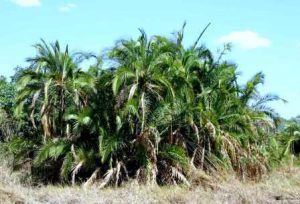
Phoenix reclinata. Photo: Bart Wursten. Source: Flora of Zimbabwe
Phoenix reclinata is probably the commonest species, occurring from altitudes of 300 m at the Haroni-Lusitu to 1500 m on the Dyke, most often in riverine vegetation.
Raphia farinifera in the Botanical Gardens has no trunk, the enormous leaves arising from ground level. It grows only in the Palm Block and at the foot of the Great Dyke plus a few places in the Eastern Districts. It likes habitats that remain wet at least below the surface. According to Bob Drummond, gardeners’ raffia comes (or used to come) from the midribs of the leaves – but is raffia all plastic now anyway?
Of the two palmate species, Hyphaene petersiana was not happy growing in the Gardens. It is a low altitude species, growing by rivers and streams and also, Tom explained, in depressions along the Valley floor. After 20 years, these specimens had only reached 2-3 metres. Borassus aethiopum looked to me rather similar, although less grey in appearance. It grows In the Haroni/Lusitu area and also near Renco Mine near Chiredzi.
We then moved on to the cultivated palms, most of which are planted close to the herbarium building.
A very distinctive genus was Washingtonia, represented by Washingtonia filifera and Washingtonia robusta, which has palmate leaves and a dense skirt of old dead grey leaves extending from the green leaves to the base of the tree. The genus is a N. American one and is named after George Washington.
Nearby was a Bamboo Palm. These appear to be so called because they do resemble bamboo – the stems have nodes and culm sheaths and often bear leaves, rather than bearing them all in a tuft at the top. This particular one was Chrysalidocarpus lutescens, the Madagascar palm.
By the road is a group of the Royal Palm Roystonea regia from Cuba. These are extra¬ordinary plants. A ringed grey leafless trunk bulging in the middle supports a green smooth trunk above (apparently technically referred to as a crown-shaft), at the top of which are the large pinnate leaves. The flowers appear where the trunk meets the crown-shaft. This genus is apparently named after General Roy Stone, an American engineer.
Amongst the many palms we were shown, I would like to mention 3. The lovely Princess Palm with pinnate leaves and delicate leaflet tips (Dictyosperma aureum), the Fish-tail Palms (Caryota spp.) and the bush Lady Palm (Rhapis excelsa).
Finally, a lady had brought a specimen of a tree from her garden. It had panicles of small flowers and ± spherical green fruits. This was named by Tom as the Candlenut, or Aelurites moluccana, which belongs to the Euphorbia family. According to Bailey’s Manual of Cultivated Plants, this tree is probably native to the Malay region but has spread widely through the Tropics.
Our great thanks to Tom for introducing us to the world of Palms.
-Mark Hyde.
The Acacia Schools
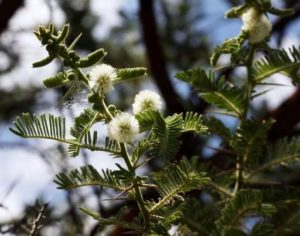
Acacia rehmanniana. Photo: Bart Wursten. Source: Flora of Zimbabwe
Bulawayo sits in thornveld dominated by Acacia karroo, Acacia nilotica and Acacia rehmanniana (see Dr H Wild’s Vegetation Map of Rhodesia) but these are not the only subjects of that large and important group that can be found within the municipal boundaries of the city. The purpose of the Schools was to introduce members of the Bulawayo branch to the great diversity of acacias within our town and to familiarize them with their specific vegetative characteristics. In all we looked at 15 species, leaving out Acacia fleckii, Acacia erioloba and Acacia ataxacantha which whilst occurring very close to Bulawayo, did not to the best of our knowledge (and we hope to be proved wrong) lie within our arbitrary limiting factor, the city boundary.
On the first Sunday in November we looked at the Acacias with spinescent stipules and on the first Sunday in December we looked at those with non-spinescent stipules.
Acacia School No. 1
These straight thorned acacias were in general most obliging in that, with the exception of Acacia sieberiana (or sieberana as you might prefer it) they grouped themselves very conveniently in two very accessible localities. We had to work hard for the “paper bark thorn” though. An uncomfortable slog of about a kilometre over newly ploughed land was very trying for all, especially the less agile. On the way we took in Acacia arenaria. Our next stop opposite Brady Barracks yielded Acacia karroo, Acacia nilotica and Acacia rehmanniana. On hand too were two Faidherbia albida, which, for old time sake, we included in our register of 15 species. These two trees and one other Faidherbia opposite the National Free library lie well outside the distribution given on the Coates Palgrave map and the fact that they are all found within the old Victoria Falls railway corridor suggests that perhaps they were distributed by the “iron horse”.
Our next stop was in the same greenbelt zone on the Harare road about a km to the north. Here we found Acacia robusta subsp. robusta and Acacia gerrardii and then moved on to a very late and well-deserved tea at Girls’ College.
-Ian McCausland.
Acacia School No. 2
Acacias provide a wide-ranging and interesting field of study and last Sunday we had erudite talks by Anton Ellert, Dennis Murray, Geoff Archer and Ian McCausland on the species we visited.
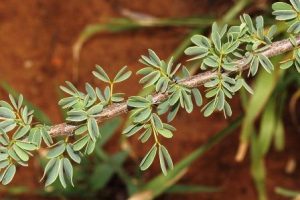
Acacia mellifera. Photo: Bart Wursten. Source: Flora of Zimbabwe
Our first visit was to Glengarry area where we studied Acacia mellifera with its fresh looking little round leaves of greenish grey. The bark was an attractive greenish/purple and this acacia would enhance the shrubbery of any garden.
Next we drove onto the new Cecil Avenue extension where we found numerous dainty, feathery Acacia chariessa whose small fine leaflets give this shrub a lacy appearance.
Then we visited a rather unusual area, namely the industrial sites where, on a vacant stand, we found numerous Acacia polyacantha in full flower, its white inflorescence densely covering the crowns of the trees like snowy mantles. We examined its flaky bark and were told that it is a fast growing subject. I was mentally trying to calculate its rate of growth in inverse proportion to my life expectancy and wondering whether it might be a good idea to acquire one for my garden. It certainly would be an asset.
Next visit was to the suburb of Montrose where we examined and enjoyed a magnificent, knobbly Acacia nigrescens, estimated to be between 100 and 150 years old. It stands about 13 metres high with an equal spread, providing most welcome shade. Its old gnarled trunk was thick and wrinkled with age and some of its attractive round leaves had mottled markings, which made me wonder whether trees also go grey in old age?
We went on to look at Acacia tortilis, sniffed the sweet scent of its creamy white globose flowers and learned that baboons, game and cattle favour its pods. Its inner bark is used to make rope and sparrow weavers like nesting in it, always on the west side.
Last but not least we went to look at some superb specimens of Acacia galpinii at Hillside dams, enjoying the welcome shade of these giants and an equally welcome, if belated, morning tea. In addition we looked at Acacia schweinfurthii, the scandent creeper growing on the banks of the stream linking the Upper and Lower dams.
As usual, Ian had prepared, in his meticulous way, handouts of full-paged data and illustrations concerning each specimen we examined which is a tremendous help on these outings and much appreciated by all of us studying the fascinating world of trees.
-Clem van Vleit.
THORA’S HERBAL HINTS
The Citrus family – Rutaceae
1. Lemon – Citrus medica or Citrus limon. Probably a native of Medea part of the present state of Iran between the Tigris basin and the Caspian Sea.
Mentioned in Virgil for its properties of sweetening the breath and steadying the pulse rate of elderly men.
Medically recognized as an antiseptic and hyposensitive – prescribed for arteriosclerosis.
For a long time used as a moth deterrent, also giving clothes a pleasant scent – leaves and flowers used.
Lemon juice helps to quench the thirst especially when the patient is feverish.
For liver complaints a lemon cut into rings and infused in boiling water to which a tablespoon of honey is added, brings quick relief.
For influenza, colds and chills, go to bed and drink the juice of one lemon in a cup of hot coffee – induces perspiration. For sore throats gargle or rinse the mouth with lemon juice, hot water and a teaspoon of salt.
To arrest nasal haemorrhage apply a wad of cotton wool soaked in lemon juice, to relieve headaches rub temples with a cut lemon or apply slightly salted lemon juice compresses to the forehead.
For neuralgia and rheumatism gently rub the painful areas with half a lemon. To aid digestion and relieve stomach ache and nausea put a tablespoon of lemon juice and a little salt into a glass of hot water and sip slowly.
Used in the kitchen lemon juice preserves and effectively kills bacteria on fish, shell fish, meat and vegetables – has probably prevented many cases of food poisoning.
Ink and vegetable stains on fingers can be removed with lemon juice, also removes rust stains on white linen and cleans copper ware and silver.
In beauty treatments lemon juice helps to keep hands soft and smooth, strengthens nails, causes freckles to disappear, lightens the complexion, counteracts oily skin and prevents wrinkles.
All citrus seeds crushed and mixed with honey and taken first thing in the morning are a good vermifuge. In fact the uses of the humble lemon are endless.
For the Tree Society when on a long hike or climb a piece of lemon leaf sucked in the mouth will prevent dryness and sweeten the breath.
2. Orange – Citrus aurantium and Citrus sinensis
The fruit is widely used and a great source of vitamin C, as are other citrus fruits. The peel contains vitamin D. The leaves and flowers are also valuable aids to health.
Orange flower water was always kept in the home for those perpetual feminine malaises ranging from indigestion to the vapours. The fresh flowers and leaves have sedative and antispasmodic properties. To soothe nerves, calm palpitations and as a remedy for insomnia, boil a handful of leaves in half a litre of water till reduced to half the quantity. Drink 2-3 cupfuls per day, one before retiring. This has also been used with some success in the treatment of epilepsy.
With the peel of oranges (provided they have not been sprayed with chemicals) you can make an excellent aperitif wine that improves with age. Macerate the peel of six oranges in half a litre of brandy for 15 days; add two litres of wine and some sugar syrup to taste. Strain and store in tightly corked bottles.
3. Zanthoxylum capense
This is a much-used indigenous tree in herb medicine. The fruit, which tastes lemony and acrid, is an old folk remedy for treating colic, flatulence, stomach aches, pains and cramps. The ripe berries are often dried and stored for this purpose. A tea made from the leaves may be taken for stomach upsets, diarrhoea, cramps and intestinal worms. The same tea can be used as an excellent remedy for colds and flu – also used to gargle.
The bark, pounded and chewed is a tonic for blood conditions and skin eruptions – also a snakebite remedy. Crushed bark is also applied to the bite externally.
The fresh bark has pain killing properties – can be used for toothache, lumbago and sciatica. The twigs are chewed and used as toothbrushes for strengthening teeth and gums.
A strong tea made from the fresh leaves is used to wash infected sores, scrapes and grazes; dabbed on to insect bites.
This is a small tree, slow growing from seed and well worth a place in the garden.
Insect Repelling Potpourri
4 cups dried Zanthoxylum leaves
A few berries
3 cups dried lavender tree (Heteropyxis dehniae) leaves
2 cups dried minced citrus peel (orange, lemon or naartjies)
1 cup crushed Cloves or nutmeg.
Few drops essential oil (lavender or lemon oil)
3 cups wildeals dried leaves and flowers or 3 cups wild basil dried leaves and flowers.
Mix all ingredients together. Add oil. Shake well in sealed jar daily for 2 weeks. Add more oil. Shake well. Place in bowls on windowsills to keep mosquitoes and flies away. Sachets can be placed in drawers or cupboards.
Wildeals is the indigenous Artemisia and of course you can use the herbal basils and lavenders instead. Dried Tarchonanthus camphoratus leaves and flowers may also be added.
Chedgelow 5 December 1993
Chedgelow farm was a kaleidoscope of greens as we drove down the winding road through the miombo woodland to the spacious car park. With Phil in the lead, the party with a predominance of History Society members explored the “delights” of the bush so close to town. Clerodendrum wildii with purple petioles and an obnoxious smell from the crushed leaves made a great impression to judge from the many surprised faces. The use of Latin for specific names caused some anguish to some guests especially with a Cassia abbreviata whose long seed¬¬pods were anything but abbreviate. With all the Msasa woodland around us it was an opportunity to fit the ‘Hanging Tree’ of North Avenue fame into the theme of History and Trees. Although no record of any hangings is known to exist, Frederick Courtney Selous is reputed to have shot a number of rifle rounds into the tree either as a weapons test or to improve his already legendary marksmanship.
For those who have attended, “Music under the Stars”, the sound system has often been camouflaged behind a row of small Parinari curatellifolia situated on a flat rock facing the amphitheatre while a colony of tall Aloe excelsa formed the “wings” to the stage. An intruder in the scene was a Ficus thonningii whose roots were noticed sneaking down the rock into the remains of an ancient grave wedged into a crevice.
Shortly after this we settled ourselves on the rocks and Tim Tanser gave us a most informative talk about William Harvey-Brown, a pioneer and at one time the owner of the land on which Chedgelow is situated. William Harvey-Brown was an American naturalist who met up with Frank Johnson in South Africa and was persuaded to join the Pioneer Column. He gained the nickname “Curio Brown” as his interests led him to collect anything with a natural history leaning. As a Pioneer scout he was also involved in the Battle of Bembezi and although being pro-British he objected to being ordered about by the officers attached to the column. After the break-up of the column he went prospecting until his land grant became available, this being Arlington Estate later known as Kentucky Farm.
Harvey-Brown and his American born wife had four children, three of whom died young and after his death in 1913, Mrs. Harvey-Brown and the remaining child returned to the United States thus ending a short but interesting part of this country’s early history.
At the conclusion of the talk a short prayer and a minute’s silence was held in memory of the Alan Wilson Patrol who perished on the 4th December 1893.
After the enjoyable picnic/braai the outing ended while the rain conveniently waited until 3.30! Very many thanks to John and Stella Danckwerts for a super day and for the “bush loo’s” and to the members of both societies who contributed so much.
-Andy Macnaughtan
NYARUPINDA CATCHMENT DECEMBER 1995
Good wishes for a very happy Christmas, here is something we could enjoy together in 1994 before the grasses shed their seeds. How would you like to visit a botanical paradise? 1½ hours driving distance from Harare in the Ayrshire district. The place is on Nkwali (which means Francolin) part of Nchefu marked on the Raffingora map 1730A2. The terrain is the alluvium of the Marasha River, which is a tributary of the Susije; adjoining it is agricultural land dotted with termite mounds, the altitude hereabouts is approximately 5600ft asl so the vegetation is rather different from that nearer Harare. These rivers are dry as a result of the December drought.
The Scene
Wild Life has come to us at Tinto house; one more Tiger Snake with its tail caught in a window, a clutch of Tree Agama eggs in the sandpit on the lawn close to the house (which had not been frequented for 10 weeks whilst we were away). A Rusty Spotted Genet inside the security fence, it was killed by our dog who left the corpse near our bedroom window. The most interesting find was on the brick path surrounding the house; it was an example of arthropod mimicry. This looked like a piece of Acacia bark bearing paired straight woody spines on a raised boss. It was a spider, it has to be seen to be believed – in order to see it, it is captive at the moment in a wood Fleurette box of the sliding wooden lid has been replaced by transparent rigid plastic with air holes punched in it. It spins a web around live offerings of potential food, paper wasps, (almost dead) moths, cockchafer beetles, flies and ants. The spider has eaten the contents of the former insect. The next food offered will be tree caterpillars. If these are not available ones from the vegetable garden may be acceptable.
If anyone recognises this spider from this description please tell us its name and provide more details of its life and habits, because it has such a resemblance to tree bark.
Zimbabwe in Mozambique
To date 9 Sight Record Sheets have been completed for the Protea Atlas Project, which is organised by the Botany Department at Cape Town University. The writer has put Raffingora on the projects’ Southern Africa map – this reveals that Zimbabwe occurs in the square called Mozambique! The organizers are anxious for more participants so Maurice and I went to the Botanical Paradise on Nkwali to record a glade of Faurea saligna in abundant flower bud about three weeks ago – we must go again soon, to look for pollinators.
First Aid Kit in a Bottle
It is not whisky but Tea Tree Oil. It features in a leaflet available at the chemist opposite Greatermans.
Whilst in Australia my feet needed attention – those hikes in Canada and holiday sightseeing added to the legacy of crooked toes from chilblains suffered during childhood in England. Anyway the Podiatrist gave me a standard pedicure, which included the application of Tea Tree Oil from Melaleuca alternifolia – this was known to the Aborigines and scientifically recognized throughout the world during the 1930’s. Now that Medical Practitioners realize that antibiotics and synthetic drugs are not always appropriate especially for minor ailments Tea Tree Oil is once again becoming a household necessity. Hikers and tree walkers can use it to heal toenail infections, soft corns, athlete’s foot and as a foot freshener – no more smelly feet – could children be persuaded to use it when they remove their favourite (unwashed) footwear!
That’s all for this month as we seem to be rather busy.
P.S. Christmas and New Year good wishes to Dear Mrs. Masterson, Tom and Bob.
-Benedicta Graves
ANDY MACNAUGHTAN CHAIRMAN


